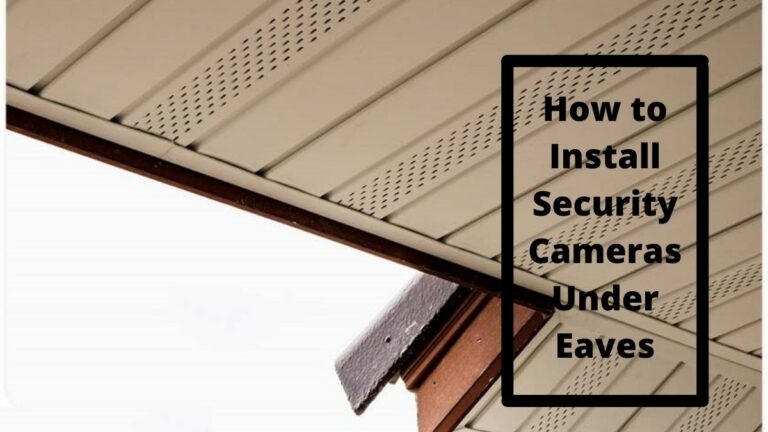Mounting a security camera to an eave is a good solution for homeowners and customers who look for the best places to put monitoring cameras at home.
But, to install security cameras under eaves correctly you may need accurate and precise power cable connection, effective tools, and knowledge of the proper installation processes without a risk-barring experience.
Nonetheless, it is easier to install without hiring an expert, compared to the thoughts of many homeowners.
So, to make it easy for you also the installation process must be done according to specific steps to avoid falling off during strong winds and unfavorable weather conditions.
This article will cover the easiest way to install security cameras under eaves, even for those who had never done something like this before.
TOOLS AND MATERIALS USED FOR THE INSTALLATION PROCESS
For the installation, there will need to grab some extra tools apart from the typical home tools.
- Fish tape: You might use a 25ft fish tape, but it is advised to have at least a 50ft/15m fish tape.
- Headlamp/flashlight.
- Regular hole drill: If you are choosing the drilling options.
- Electrical tape.
- Siding removal tool.
- Ethernet splicing tool.
- A ladder: To comfortably install a security camera, you will need a ladder. Your house is one floor or two doesn’t matter unless you are incredibly tall or the eave is very low.
- Screwdriver.
- Nuts and screws: It regularly comes within the camera kit.
- Ethernet cable: You might need to get extra Ethernet cables in cases where the ones in the camera kits wouldn’t be enough.
- Aluminum strip close to a quarter-inch thick.
- Paint to match the soffit.
How do you mount security cameras under Eaves Like Professionals?
To install security cameras under eaves there are some rules you should follow. First, you should select the best place for your security camera to put it, after that set a plan for the wire route of your system. Second, Run the camera wires through holes in the soffit, and then attach your security camera.
Now, Let’s dive and see the details of every step
Step1: Put a Plan for The installation Process
Starting the whole process with planning is the best. Installation in eaves requires the security camera to face a direction that can cover a large area of view.
Without mapping out the best path and place to be, you might end up installing cameras with so many blind spots.
Grab a pencil and a paper, and draw out a quick sketch of the house. Then, try to mark areas in your eaves where the security cameras should be located.
Step2: Measure the Wire Route
The 2nd step in how to install security cameras under eaves is to take the measurements.
Measure the length of the eave (distance of the space between the wall and the end of the eave.) With this, you can select the aluminum strip to match perfectly without sagging.
An aluminum strip of a quarter-inch thick might be hard to cut through if it is too long for your measurement.
Grab your camera kit and open it up. Check for the components available. The main attention should be on checking if the Ethernet cable will connect from the network video recorder through your wire ways down to the eave.
In case you have a DVR and CCTV camera that use Coaxial cable, you can do the same and measure the cable.
You can do this by going to your attic and measuring through the path you want the cable to pass. This is part of the little stressing steps in the installation, but it will take only a few minutes.
Step3: Drill Holes in the Soffit
While still in the attic, locate the best part closest to the pathway proposed for the Ethernet cable, then drill a hole through the soffit.
This hole is for the Ethernet cable to pass through to the security camera port. Be careful not to make a mess of your soffit. Take a good shot and drill.
Rather than the drilling, there is an alternative that involves opening part of the soffit in the eave for the passage of the Ethernet cable.
If you choose this, simply go outdoors, climb a ladder and look carefully at the soffit. The vinyl soffit is usually connected to another by joints. Check for the joints, and they are usually inches apart and easy to identify.
Peel back the soffit piece with the siding removal tool, which has a little hook at one end to disjoint it easier, even when connected with small nails or pins.
An opening will be seen, and it can serve a passage of the Ethernet cable, but it doesn’t look effective.
Step4: Run Security Camera Cables
After fishing the previous step, bring the fish tape that you have and after that Insert a fish tape through the hole or split you made earlier and let it go as many inches down to where you want to place the network video recorder.
Go back in and tape one end of the Ethernet cable to the fish tape. Return outside and draw out the Ethernet cable.
Step5: Mount the Cam
The next step in how to install security cameras under eaves is to connect the security camera to the aluminum strip.
Drill holes through the aluminum strip, depending on the number of holes in the security camera brackets.
Paint the aluminum strip to make the color of the eave. Screw the camera’s bracket to the aluminum strip and tighten with nuts at the back.
With the secured camera on the aluminum strip, it is time to connect it to the Ethernet cable.
Splice the Ethernet cable with the splicing tool and make it firm to the Ethernet jacks in the camera kit. This is also not tasking. Just follow the instructions in the guide.
Afterward, connect the power source of the camera and the Ethernet cable to the security camera.
The connection needs to occur before the aluminum strip and camera are fixed to the eave. Slide in the aluminum strip to the eave by simply bending it to enter into the vinyl soffit supports perfectly.
Step6: Setup The Configuration
Before that, go back to connect your other Ethernet cable to the network video recorder, which is the mind recorder of the footage, and save them up as a storage device.
Set up your network video recorder. The camera kit will have manufacturer’s guides and instructions, so it will be pretty easy to do.
The interface and the operating system of most NVR are designed in a simple way that will make it easy for owners to operate.
Now you know how to install security cameras under eaves, just check if the angle is acceptable and if the camera is working perfectly.
If Not, Adjust the angles, and connect your cameras to any viewing devices such as monitor screen, or smart TV, or download the camera mobile app to enjoy monitoring your property from the smartphone.
For More Details Watch the Below Video
Source: Jim Odell
SUMMARY
The installation is a simple DIY process targeted to get the same result as security camera installation companies. The materials needed, the tools, and the steps involved have been tested to offer utmost satisfaction.
Nevertheless, you are advised to line the hole where your wire goes through in an aluminum soffit to prevent abrasions, but it is unnecessary if it is the typical vinyl soffit.

